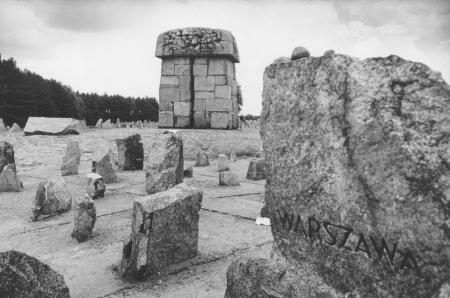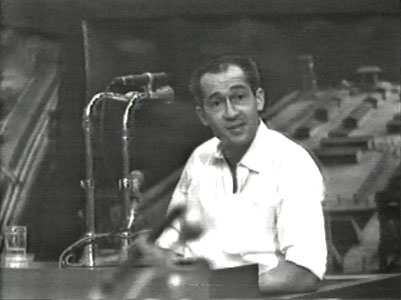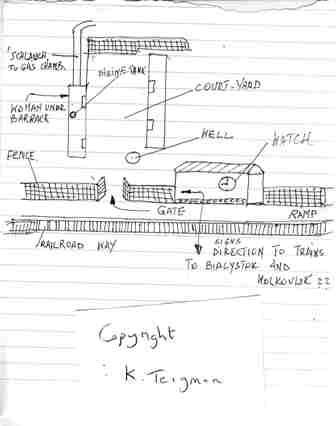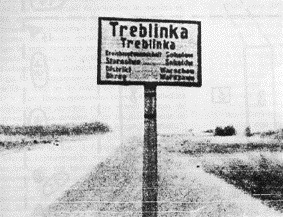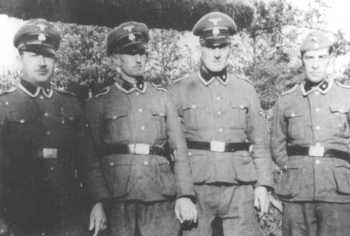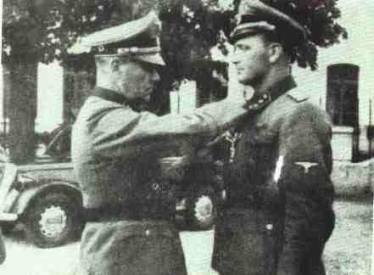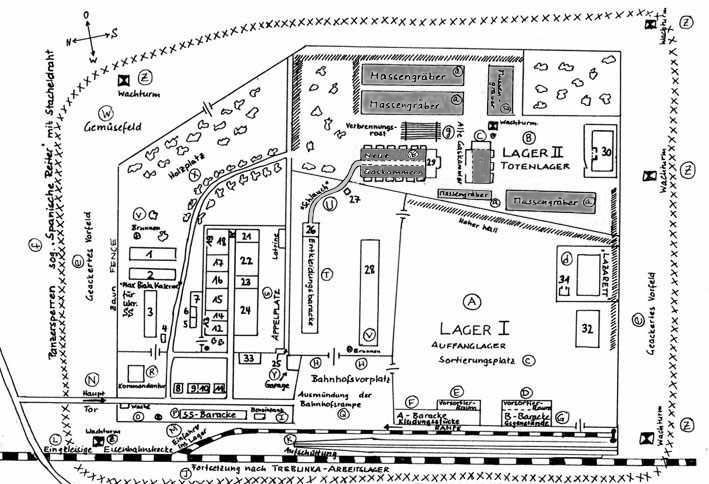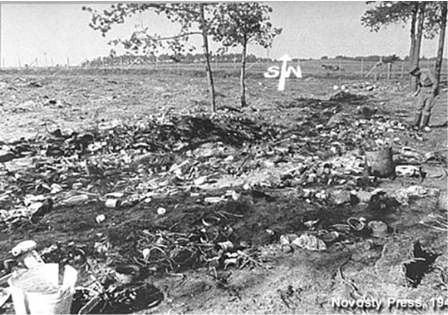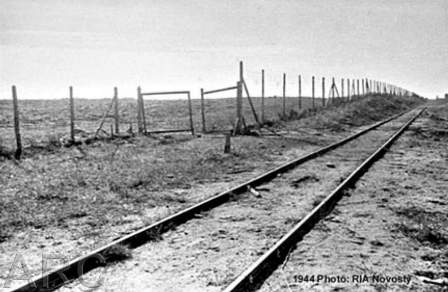Holocaust Education & Archive Research Team |
Treblinka
Treblinka Galleries Treblinka Articles -------------
A-R Leadership
A-R Articles
Action Erntefest Modern Research | ||||
Treblinka Death Camp Revolt August 1943 (Testimonies)
A brief summary of the revolt: Jewish inmates organized a resistance group in Treblinka in early 1943. When camp operations neared completion, the prisoners feared they would be killed and the camp dismantled. During the late spring and summer of 1943, the resistance leaders decided to revolt.
On August 2, 1943, prisoners quietly seized weapons from the camp armory, but were discovered before they could take over the camp. Hundreds of prisoners stormed the main gate in an attempt to escape. Many were killed by machine-gun fire. More than 300 did escape -- though two thirds of those who escaped were eventually tracked down and killed by German SS and police as well as military units. Acting under orders from Lublin, German SS and police personnel supervised the surviving prisoners, who were forced to dismantle the camp. After completion of this job, the German SS and police authorities shot the surviving prisoners.
Individual Testimony at the Adolf Eichmann trial:
Kalman Teigman
Q. Was Kapo Moniek one of the organizers of the revolt?
A. Yes, later on he was one of the organizers of the revolt. There were a few others – there was also an engineer there by the name of Galewski – he was the Camp Elder. There was also a young man named Rudek – I don’t know his surname – but I know he came from Plock, and he told me then, that he had a mother from Palestine.
Q. What was the plan you drew up for the revolt and the escape?
A. At first, there were two plans. Two children of the Hofjuden were employed in polishing the shoes of the Germans, and they worked in the hut where there was an arms store. This store was built by the experts amongst the Hofjuden, the fitters and the construction workers. An extra key to the store had to be made. And, in fact they made a key, and the children were to go into the store, to remove arms in sacks, and to place them on refuse carts- guns, bullets, hand grenades and revolvers.
They were to place the smaller items in buckets, items which could be carried by hand. The arms were to be distributed in various places in the camp, such as in the motor workshop, or in the heaps of potatoes, and similar places.
Thereafter, we were to ask the SS men to come to all the workshops and these places, under various pretexts, and to kill them inside the workshops, and in this way to rid ourselves of most of the SS men. And this is how, it turned out in fact.
Q. And in this way you carried out your plan ?
A. Not altogether, we wanted to, but it did not succeed entirely.
Q. Who was the commander of the revolt ?
A. I said there were a number of people.
Q. Who were they?
A. There was the Engineer Galewski.
Q. Did he survive?
A. He did not survive.
Q. What happened to him?
A. Apparently he was killed during the revolt.
Q. Who else?
A. And there was Rudek, whom I mentioned – he was a mechanic.
Q. Did he remain alive?
A. He also fell. There was a young man named Zelo, a Jew from Czechoslovakia, it was said he was a Czech officer.
Q. What happened to him?
A. He was also killed.
Q. Was the entire command killed?
A. I believe so, for I never came across any one of them. There was another one, whom it may be of interest to mention, Rudolf Masaryk – it was said he was a relative of the President of Czechoslovakia. We did not know whether there was any truth in this. He was not a Jew, but his wife was Jewish. He used to take care of Kurt Franz’s dog.
Q. What happened to him?
A. Apparently he too, was killed.
Q. Was he also together with you?
A. He was all the time.
Q. But did he also plan the revolt?
A. So I was told. I did not know everything, for not everybody was in the know.
Q. What was your role in the revolt?
A. I was to reach a particular spot and to receive arms.
Q. How did you carry out the revolt?
A. The revolt was to start at four o’clock in the afternoon - and between two and two thirty, those children whom I mentioned were to enter the store. And, indeed they went in and brought out some arms from the store, mainly hand grenades, and some revolvers, and also ammunition.
At the same time, two men went into the building, that is to say the hut where we lived, and that was forbidden. These two men were caught and made to undress. Money was found on them, evidently, they wanted to prepare money for themselves, in case they succeeded in escaping. They were caught and one of the camp commanders stripped them and began beating them. This was about half an hour before the commencement of the revolt.
A great commotion broke out. All the time people kept coming back and reported that they were beating them, and they would certainly reveal information – perhaps they had already done so – and if that was the case, there was nothing to lose, we should start right away. But most of the people had been advised that the revolt was to begin at four. However, as I ascertained - we were told this afterwards, Rudek fired at the SS man who was beating these two young men, and subsequently a grenade was thrown.
Q. Was that how it began?
A. This was the signal for the revolt to commence. And after that, the explosions began. There was a young man who used to disinfect the huts of the Germans and the Ukrainians. He had a receptacle on his back, with a hosepipe, with which he sprayed disinfectant.
On that day this young man was to mix the chemicals with fuel, petrol, and in fact he did so. In addition to that, there was a large tank of petrol near the garage. I think it must have contained several thousands litres of petrol. This tank was also set on fire. It exploded and spread flames along the fence, which was covered with dried foliage, and it began burning.
I was at the workshop refurbishing aluminium utensils. I knew that I was to receive arms at the garage. I ran in fact, towards the garage, but I could not reach it, for the fire from the tank prevented me from getting near. Then I turned around and ran in the direction of the Lazaret towards the second gate.
Q. And you escaped from there?
A. And I escaped from there.
Q. How did you break through the fence?
A. I simply climbed over the fence. There had already been people who had escaped that way, and on the fence there were already blankets and boards, and we climbed over on these.
Q. Did the Germans pursue you?
A. The Germans chased us on horses and also in cars. Some of those who escaped had arms. I also ran with a group that possessed a rifle and revolvers. These people returned the Germans’ fire and the Germans withdrew. In this way we managed to reach the forest which was near this camp.
Q. How many people were saved from Treblinka at the time?
A. I think about a hundred and fifty men fled in the direction I took.
Sources:
Nizkor PRO Bundesarchiv
Copyright Noah S. Archer H.E.A.R.T 2007
|
